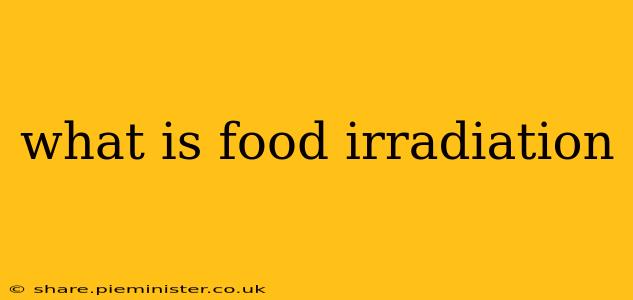Food irradiation, also known as irradiation processing, is a technology that improves the safety and extends the shelf life of food. It involves exposing food to controlled doses of ionizing radiation, a process that significantly reduces or eliminates harmful microorganisms like bacteria, parasites, and insects, without significantly affecting the nutritional value or sensory qualities of the food. Think of it as a sophisticated way to pasteurize food, but using radiation instead of heat.
This process doesn't make food radioactive. The radiation used doesn't alter the food's chemical structure in a way that makes it radioactive; it simply disrupts the DNA of harmful organisms, rendering them unable to reproduce or cause illness.
How Does Food Irradiation Work?
Food irradiation utilizes three primary sources of ionizing radiation:
-
Gamma rays: These are emitted by radioactive isotopes like cobalt-60 or cesium-137. Gamma rays are highly penetrating and effective for treating larger packages or bulk foods.
-
Electron beams: These are high-energy electrons accelerated to near-light speed. They are less penetrating than gamma rays, making them suitable for treating thinner products or surface sterilization.
-
X-rays: These are produced by machines and have a penetration power similar to gamma rays.
The type of radiation used depends on the food product and the desired outcome. The process takes place in specialized facilities with rigorous safety measures in place.
What are the Benefits of Food Irradiation?
The primary benefits of food irradiation are:
-
Enhanced Food Safety: By eliminating harmful bacteria, parasites (like Salmonella, E. coli, and Listeria), and insects, irradiation significantly reduces the risk of foodborne illnesses.
-
Extended Shelf Life: Reducing microbial contamination slows down spoilage, allowing food to stay fresh and safe for consumption for a longer period. This minimizes food waste and reduces the need for preservatives.
-
Improved Food Quality: While some argue about potential slight changes in taste or texture, many studies show minimal impact on the overall quality of irradiated food. It can even improve the appearance of some fruits and vegetables by delaying ripening.
-
Pest Control: Irradiation effectively controls or eliminates insect infestation in grains, spices, and other dry food products without the use of harmful pesticides.
-
Reduced Use of Chemical Preservatives: Because irradiation extends shelf life, the need for chemical preservatives is often lessened.
What Foods are Commonly Irradiated?
A variety of foods can be safely irradiated, including:
-
Spices and seasonings: This is one of the most common applications, effectively eliminating harmful bacteria and insects.
-
Fruits and vegetables: Irradiation can extend the shelf life of certain fruits and vegetables, reducing spoilage.
-
Poultry and meat: Irradiation can help control harmful bacteria like Salmonella and E. coli.
-
Grains and seeds: This process can effectively control insect infestations and extend the shelf life of grains.
-
Dried herbs: Similar to spices, irradiation eliminates harmful microorganisms and extends shelf life.
Is Irradiated Food Safe to Eat?
Yes, according to extensive research by organizations like the World Health Organization (WHO), the Food and Agriculture Organization of the United Nations (FAO), and the U.S. Food and Drug Administration (FDA), food irradiation is a safe technology. Numerous studies have shown that appropriately irradiated food does not pose any health risks. The radiation used doesn't make the food radioactive. The process is strictly regulated to ensure safety and efficacy.
Is Irradiated Food Radioactive?
No. Food irradiation does not make the food itself radioactive. The radiation used disrupts the DNA of harmful microorganisms, but it does not change the food's atomic structure to become radioactive. This is a crucial point often misunderstood.
What are the Potential Drawbacks of Food Irradiation?
While generally safe and beneficial, food irradiation does have some potential drawbacks:
-
Cost: Irradiation processing can be more expensive than other preservation methods.
-
Consumer Perception: Some consumers harbor misconceptions about food irradiation, associating it with radioactivity. This perception can affect consumer acceptance, despite the scientific consensus on its safety.
-
Nutrient Loss: While generally minimal, some slight nutrient loss may occur in certain foods.
-
Lack of Widespread Availability: Irradiation facilities are not as widely available as other food processing methods.
Does Irradiation Affect the Nutritional Value of Food?
While some minimal nutrient loss might occur, studies generally show that the nutritional impact of food irradiation is insignificant compared to other preservation methods. The nutritional benefits generally outweigh the potential minor losses.
How Can I Tell If Food Has Been Irradiated?
The FDA requires irradiated food to be labeled with the Radura symbol, which is an internationally recognized symbol indicating irradiation treatment. This helps consumers make informed choices. However, not all countries mandate labeling.
In conclusion, food irradiation is a safe and effective technology for enhancing food safety and extending shelf life. While some drawbacks exist, the overall benefits significantly outweigh the risks, making it a valuable tool in ensuring a safe and reliable food supply.
